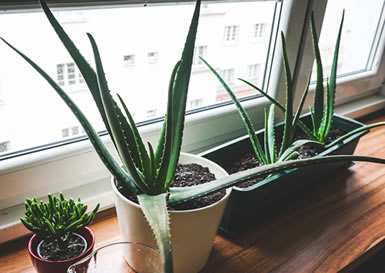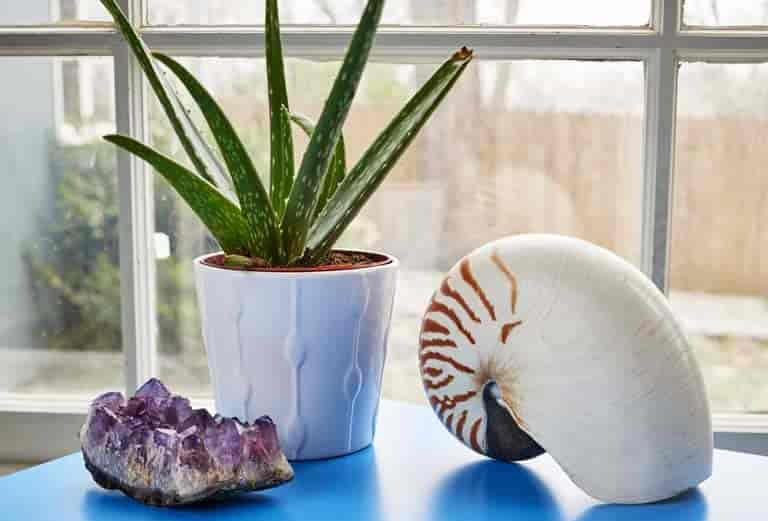In this article I address the light needs for the aloe plant. Although I touch briefly on the aloe vera plant specifically the advice throughout this article applies to all species of the aloe plant family. So, regardless of which particular aloe plant you have you will find all the information you need in this article in regards to its light needs.
Table of Contents
Aloe light requirements
Aloe plants are succulents that are across the US and in many other countries.
They are sometimes grown outdoors in specific climate zones but for the most part aloe is a houseplant and because it is grown indoors you must be especially careful with its light needs.
So, so aloe plants need sun?
Aloe plants are desert succulents that need a lot of sun.
An aloe plant requires at least 6 hours of sun per day to stay healthy.
Without adequate sunlight an aloe plant will not bloom and it will eventually weaken at the stem and start to fall over. Eventually the pant may die.
Never leave your aloe plant in a shaded area as it need direct sunlight. As best you can ensure your aloe plant gets at the very least 6 hours of direct sunlight every day.
If you can give it more sunlight than that, then you should definitely do so.
An aloe will thrive best in full sun
So, we can see that aloe plants, including aloe vera, like to receive direct light. But, sometimes direct light is not the same as full sun.
If you live in an area that gets lovely blue skies and strong sun most days then you may wonder if it is safe to leave your aloe plant in the direct path of full sunlight.
Can aloe plants take full sun?
Aloe plants are desert succulents that can take full sun. In fact, full sun is best for these plants.
They require a minimum of 6 hours of direct sunlight per day.
As a desert plant the aloe is well adapted to full sun and will actually grow best in an environment that gives it plenty of strong direct sunlight.
Be sure the plant gets the correct amount of sun
When cultivating and caring for an aloe plant you will want to ensure the plant is getting the correct type of light for the correct number of hours.
How much sun does an aloe plant really need?
An aloe plant requires direct sunlight. As a desert plant aloe has evolved to need at least 6 hours of direct sunlight per day.
If not enough direct light is available you can use a grow light.
When using a grow light be aware that it will not provide the strong light that full sun exposure would and so the plant will require at least 12 – 14 hours of artificial light.

Unlike some other succulents that can tolerate shade, such as the amaryllis, or other popular houseplants that actually require indirect light, such as the african violet, an aloe plant must be given strong direct sunlight.
Indirect light, and even direct sunlight if only given for less than 6 hours per day, will lead to a sickly plant.
The aloe plant is a tropical perennial succulent that is native to parts of Africa, Madagascar, Jordan, the Arabian Peninsula and various islands in the Indian Ocean such as Mauritius, Réunion and Comoros.
It thrives on direct strong sunlight.
Aloe is a very hardy plant having evolved to thrive in what we would term very harsh and dry conditions.
Growing in deserts the aloe plant is well adapted to strong sunlight and limited water sources (see our aloe plant watering guide).
Therefore if you want your aloe plant to thrive you need to make sure it gets plenty of direct sunlight just as it would in its native habitat.
The effects of low light on aloe
Many people wonder if it is possible to cultivate and grow an aloe plant without giving it sunlight. Can an aloe survive without sunlight?
An aloe plant cannot survive without sunlight.
As a desert succulent aloe needs at least 6 hours of strong direct sunlight per day to survive.
It is possible to use a grow light to supplement the light needs of your aloe plant.
If your amaryllis plant only gets limited sunlight then you will need to ensure it gets at least 14 hours of artificial light per day.
Aloe plants will grow best in strong direct sunlight but if you live in an area that simple does not get enough strong sunlight to grow a healthy vibrant aloe plant there are still steps you can take to help your plant thrive.
A long fluorescent grow light, like this, is sufficient and will work well especially if you have multiple plants that need some artificial light but I personally prefer to use individual grow lights that sit directly above the plants (like this one from Hortican that is pictured below).
I think the Hortican is the best grow light for aloe plants as it works as well as any other and its unique sophisticated design helps to enhance the overall look of the plant rather than detracting from it, as many other lights do.
Using this type of small localized light means you are not restricted to where you can place your plants.
It also means you can regulate the amount of artificial light getting to individual plants which you cannot do if multiple plants are placed under one long fluorescent grow light.
As well as the Hortican, which is one of my favorites, here are two other types I use – the portable clip on grow light and the beside grow light that doubles as a reading light.
The second light is a particular favorite of mine as I’m an avid reader. In my opinion it is the best grow light for aloe vera plants that sit beside your bed.
Each type of grow light serves a slightly different purpose and I find that when you choose the correct one for a specific plant it can actually help with the aesthetic look of the plant rather than detract from it.
As there are lots of different types on the market and you should be able to find one that suits your tastes and your specific plant.

If you do choose to use, or need to use, a grow light for your aloe plant still try to ensure the plant gets some natural light, no matter how weak that light is.
There is simply no substitute for natural light and grow lights should be viewed as an aid to, rather than a replacement of, real natural sunlight.
When your aloe doesn’t get enough light the plant will suffer
So what happens if your aloe plant doesn’t get its recommended amount of light or gets only indirect light as opposed to direct sunlight?
If an aloe plant does not get enough light it will initially stop blooming and the leaves will fade in color.
If the lack of light continues the next stage will be a weakening of the stems and the plant will fall over.
If the plant is deprived of light for a sustained period it will die.
Aloe plants cannot be deprived of light. More than many other houseplant this succulent absolutely needs plenty of direct sunlight.
As I have already stated if your aloe plant is not getting sufficient direct sunlight you should supplement its light with artificial light from a grow light.
Below I will briefly address the light needs of the aloe vera plant simply because it is by far the most popular aloe plant that is grown in the USA.
Aloe vera needs a lot of light compared to many other houseplants
Because aloe vera is the most popular type of aloe plant that is cultivated as a houseplant, I will address the light needs of this specific species individually.
However, be aware that all aloe plants require similar care and what is good for one type of aloe species is also good for another.
Aloe vera, like all aloe plants, requires a minimum of 6 hours of direct light per day.
More light is better.
Less than 6 hours of light will lead to problems in the plant such as faded foliage, no flowers and weak stems.
The plant will also begin to stretch and lose its form. Eventually it will die.
Light is crucial for aloe vera!
Before you give any other houseplant a prized sunny spot your aloe vera must be given priority.
An aloe vera, and all other aloe plants, must be given the most sunny spot in your home.
A window that gets plenty of direct sunlight should be allocated to your aloe plant before any other of your houseplants.
If need be, you may have to move your aloe vera from spot to spot during the day or at different times of the year to ensure it gets enough direct sunlight to remain healthy and bloom.
Alternatively you can use a individualized grow light to help maintain optimum light levels for the plant.
These are the two I use for many of houseplants that need a little extra light boost – the portable clip on grow light and the beside grow light that doubles as a reading light but most good quality grow lights will work well with aloe vera plants.
When it comes to succulents (and also my african violets because it can be used to help regulate humidity levels as well) I almost always use the Hortican as it can be regulated and … well … it just looks great.
The basic light requirements of aloe vera grown indoors
Does an indoor aloe vera require any different light than an outdoor one?
An indoor aloe vera plant requires at least 6 hours of direct light per day or 14 hours of artificial light.
Aloe vera, like all aloe plants, are desert succulents that need plenty of strong direct sunlight.
Where possible ensure your aloe vera gets as much direct sunlight as you can give it. If the aloe vera plant is kept in conditions that mean it will not get sufficient light then consider using a grow light.
As I mentioned earlier keep in mind that a grow light is only an aid for providing light to your plant and should never be regarded as a substitute to natural sunlight.
Also remember, a grow light will never supply the same type of light that strong direct sunlight can deliver.
Therefore, if you use a grow light, you will need to give your aloe vera at least 14 hours of artificial light per day as opposed to a minimum of 6 hours of direct sunlight.
Where possible try to give your plant as much natural light as possible even when using a grow light.
If you are experiencing growth, foliage or or problems with your aloe vera plant be sure to read our article on aloe vera root rot.

